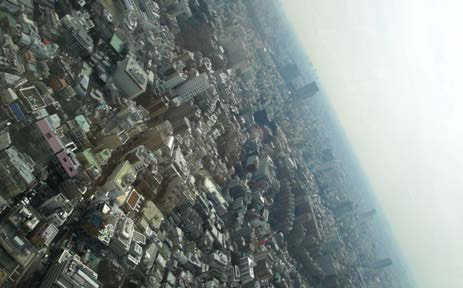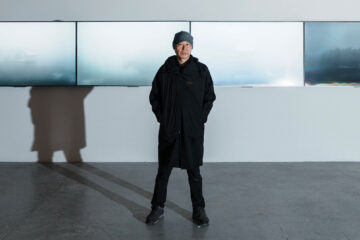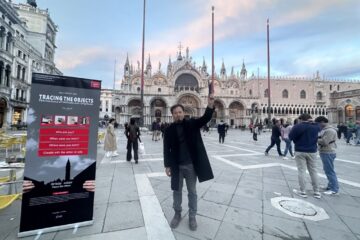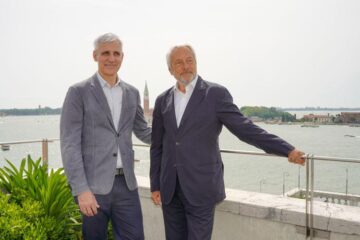UNATTAINED LANDSCAPE – THE JAPAN FOUNDATION – 55TH INTERNATIONAL ART EXHIBITION – LA BIENNALE DI VENEZIA

Press Release
June 1 – October 20, 2013
11h – 18h Wed – Sun
Preview: May 29 – 31, 2013
Timed to coincide with the Venice Biennale’s 55th International Art Exhibition, The Japan Foundation will present a special exhibition titled Unattained Landscape in conjunction with the Fondazione Bevilacqua La Masa. Focusing on the theme of identity in Japanese culture, the event will consist of works by both Japanese and foreign artists representing a wide range of genres, including contemporary art, graphic design, literature, film, sound and manga. In organizing this exhibition, The
Japan Foundation aims to foster greater global understanding, transmit information
about Japanese culture and contribute to international cultural activities.
Organizers
The Japan Foundation
Fondazione Bevilacqua La Masa
In Cooperation with
Center for Contemporary Art, CCA Kitakyushu
Supported by
NEC Display Solutions Ltd., Kikkoman Corporation, JFC Deutschland GmbH,
Kagoshima Prefecture, Kagoshima Sake and Shochu Makers Association
Unattained Landscape is an exhibition that promotes art and cultural exchanges held within The Japan Foundation to ultimately reflect contemporary creation by reconsidering and questioning the islands of Japan as potential models for contemporary culture. How can this vast and dispersed land be home to a common culture? How might it invoke common sensations in those who visit?
How does this inform judgment on communities, however scattered and fragmented, on a global scale?
Unattained Landscape challenges the archipelago – the land in its contemporary form, and whatever it means to belong to a community, including the conditions of formation and its relation to a territory. As nations are perpetually made or unmade, and as they subsequently mark territories with new physical boundaries, mental and temporal maps imperceptibly emerge to create invisible, discontinuous territories that transcend notions of a ‘nation’. These maps reveal an imaginary version of Japan; they convey desires and paradigms of a country represented not only by a group of cities, poetry, games or food, but by a fusion of fantasies invoked and inspired by Japanese and non-Japanese minds and films.
Artists invited to take part in the exhibition will contribute to opening new insights in an attempt to answer these questions.
The exhibition will feature the work of Japanese and international artists from multiple creative fields: visual art, graphic design, cartoon, literature, performance, sound and film. Ultimately, Unattained Landscape proposes an overlapping of skills, attitudes and disciplines that promotes a way beyond the repetitive format of traditional contemporary art exhibitions. This renewed curatorial approach functions as the best way of describing the hectic changes within Japanese identity, and it is a microcosm that illustrates worldwide changes in how global communities choose to conceive, represent and live life.
Participants
Meiro Koizumi, Simon Fujiwara, Shuji Terayama, Tomoko Yoneda, Marina Abramovic´, Maurizio Cattelan & Pierpaolo Ferrari, Keren Cytter, Tacita Dean, Hiroya Oku, Jim O’Rourke, David Peace, Rirkrit Tiravanija.
Curators
Didier Faustino, Akiko Miyake, Angela Vettese
Assistant curators
Sumi Hayashi, Sachiko Namba
Exhibition Design
Bureau des Mésarchitectures
Catalogue & Graphic Design
Zak Kyes / Zak Group
Venue
Fondazione Bevilacqua La Masa, Palazzetto Tito, Dorsoduro 2826, Venice
Directions
Vaporetto ACTV line 1, Ca’ Rezzonico (Academia side). Follow the street until Campo San Barnaba. Cross the campo diagonally until the Fondamenta di Rio San Barnaba. Follow the canal for a few hundred feet (past the bridge on the right) until the entrance of Palazzetto Tito.
Information about the show
Tae Mori, Yoko Oyamada, The Japan Foundation, Europe, Middle East and Africa Section, Arts and Culture Dept. + 81-3-5369-6063
Press contact in Japan
Akiko Onishi – The Japan Foundation – venezia@jpf.go.jp
Press contact in Italy
Giorgia Gallina – Fondazione Bevilacqua La Masa – press@bevilacqualamasa.it
Participants
Meiro Koizumi. Born in 1976 in Gunma Prefecture; lives and works in Yokohama. Meiro Koizumi graduated from the International Christian University and studied film at the Chelsea College of Art and Design in London. His plot-based works and performances, which are characterized by intense physical movement, are filled with sensational violence. While presenting biting criticism of authority and social norms, Koizumi reveals an underlying sense of vulnerability and humor. He has held solo exhibitions such as MAM Project 009: Koizumi Meiro (Mori Art Museum, Tokyo, 2009), Broken Hero, Beautiful Afternoon (Artspace, Sydney, 2011), Defect in Vision (Annet Gelink Gallery, Amsterdam, 2012), and Projects 99: Meiro Koizumi (The Museum of Modern Art, New York, 2013). Simon Fujiwara. Born in 1982 in London, Simon Fujiwara spent his childhood between Japan, England, Spain and Africa. In dense dramas about personal relationships, family relations, politics, architecture and history, his work explores biographies and ‘real-life’ narratives through a combination of performance, video, installation and short stories. Often appearing within his own works and assuming various guises, from anthropologist to erotic novelist, he also works with a cast of friends, family members and collaborators who present versions of themselves and their own biographies as characters within his dramas. In linking fictional and real people as well as locations and events, he explores the boundary between the real and the imagined, often revealing the very fiction of such distinction.
Shuji Terayama. Born in 1935 in Hirosaki, Aomori Prefecture. Terayama began to write tanka and haiku poems in junior high school and submitted his work to newspapers and magazines. Continuing to devote himself to poetry as a student at Waseda University, he developed friendships with Taichi Yamada, Makoto Ooka and Shuntaro Tanikawa. In 1955, Terayama was forced to leave the university due to illness. While publishing collections of poems and essays, he began to write scripts for radio and TV dramas around 1959. In 1967, he formed the Tenjo Sajiki theatre troupe with Tadanori Yokoo, Yutaka Higashi and Eiko Kujo (later Kyoko). The group attracted a great deal of attention through a succession of avant-garde productions beginning with The Hunchback of Aomori, The Crime of Fatso Ooyama and La Marie Vison. Terayama was also involved in producing countless films, including a number of experimental works, based on his scripts, which along with his theatre works earned him international acclaim. In 1983, he died of cirrhosis of the liver in a Tokyo hospital. He was 47.
Tomoko Yoneda. Born in 1965 in Hyogo Prefecture; currently based in London. Yoneda completed a masters course at the Royal College of Art in London in 1991. Her ambitious work, based on the themes of memory and history, has =a journalistic focus. She has shown her work in exhibitions such as Beyond Memory and Uncertainty (Shiseido Gallery, 2003), Non-Sect Radical, Contemporary Photography III (Yokohama Museum of Art, 2004), After the Thaw (Shugo Arts, 2005), Venice Biennale (2007), Hara Museum of Contemporary Art (2008), Roppongi Crossing 2010: Can There Be Art? (Mori Art Museum, 2010), Kuandu Biennale (Taipei) and the 2012 Kiev Biennale. Yoneda is scheduled to hold a solo exhibition later in 2013, on Saturday, July 20, at the Tokyo Metropolitan Museum of Photography.
Marina Abramovic´. Born in Belgrade and lives and works in New York. Since the beginning of her career in Belgrade during the early 1970s, Marina Abramovic´ has pioneered performance as a visual art form, creating some of the most important early works. The body has always been both her subject and medium. Exploring her physical and mental limits in works that ritualize the simple actions of everyday life, she has withstood pain, exhaustion and danger in her quest for emotional and spiritual transformation.
Maurizio Cattelan and Pierpaolo Ferrari (Toiletpaper ). TOILETPAPER is a picture-based magazine founded in 2010 by Maurizio Cattelan and Pierpaolo Ferrari. TOILETPAPER images have been reviewed by weekly and art magazines worldwide and have appeared in special issues of magazines such as Vice and Hunger. In May 2012, TOILETPAPER was also exhibited on the High Line Billboard in New York City. In the same year images taken from the first six issues were published in an anthology with selected narrative texts, which was reviewed in The New York Times’ Top 10 Photo Books. Maurizio Cattelan and Pierpaolo Ferrari are now working on the eighth issue, to be released in June 2013. Toiletpaper is published and distributed by Damiani Editore.
Keren Cytter. Born in Tel Aviv, and lives and works in New York. She creates films, video installations and drawings that represent social realities through experimental modes of storytelling. In her films, emotional status of the characters and sound/ music effects are interwoven into the picture, sometimes monotonously and sometimes passionately, thus playing a very important role. Characterized by a non-linear, cyclical logic, Cytter’s work consists of multiple layers of images including linguistic conventions and traditional interpretation schemata. She also formed a theatre group, D.I.E. Now (Dance International Europe), and has presented theatre projects, which consist of dance, video and music.
Tacita Dean. Born in Canterbury (UK) and lives and works in Berlin. The films, drawings and other works by Tacita Dean are extremely original. Her recent film portraits express something that neither painting nor photography can capture. They are purely film. And while Dean can appreciate the past, her art avoids any kind of academic approach. Dean’s art is carried by a sense of history, time and place, light quality and the essence of the film itself. The focus of her subtle but ambitious work is the truth of the moment, the film as a medium and the sensibilities of the individual.
Rirkrit Tiravanija. Lives and works in New York, Berlin and Chiang Mai. Since the early 1990s, Tiravanija has explored a new aesthetic paradigm of interactivity. He has cooked and served food to his audiences, set up a recording studio in a museum, reconstructed his apartment inside a gallery for visitors’ use, and provided opportunities for numerous other everyday activities to occur within art spaces. Tiravanija is a catalyst; he creates situations in which visitors are invited to participate or perform. In turn, their shared experiences activate the artwork, giving it meaning and altering its form.
Hiroya Oku. Hiroya Oku currently lives in Tokyo. In 1992, Oku began publishing the Hen: Suzuki-kun and Sato-kun series in the manga, Weekly Young Jump. He later created the HEN and 0 1 Zero One series, and followed in 2000 with the ongoing series GANTZ, whose sales exceeded 20 million copies. In 2004, GANTZ was released as an animated TV series, and in 2011 it became a live-action film.
Jim O’Rourke. Born in Chicago; currently living in Tokyo. In addition to building bridges between contemporary and popular music as music director for the Merce Cunningham Dance Company, O’Rourke has also earned a loyal following for his work as a member of the band Sonic Youth and his participation in numerous albums by various artists. He received a Grammy award for his production of Wilco’s A Ghost is Born in 2004. O’Rourke is highly regarded as a prominent figure in the current American music scene. Also well-versed in Japanese culture, he is active in a variety of activities such as Akira Sakata and the Boredoms, and a critical review of the work of filmmaker Koji Wakamatsu.
David Peace. Born in West Yorkshire (UK) and lives in Tokyo. He is the author of the Red Riding Quartet (Nineteen Seventy-Four, Nineteen Seventy-Seven, Nineteen Eighty and Nineteen Eighty-Three), which was adapted into a three-part Channel 4 series (2009); GB84 which was awarded the James Tait Black Memorial Award; and The Damned Utd, the film version of which was released in 2009. Tokyo Year Zero, the first part of his acclaimed Tokyo Trilogy, was published in 2007, and the second part, Occupied City, in 2009.
Curators
The architect and artist Didier Faustino lives and works in Paris, where he explores the relationship between body and space. His international projects are characterized by their fictional dimension, criticality, freedom of codes, and their ability to offer new experiences to the individual and collective body. Several works comprise the collections of major institutions, including MoMA, Gulbenkian and Beaubourg.
In 2009, Faustino curated Evento – a new artistic and urban event in Bordeaux. He currently teaches at the Architectural Association in London, and he works on several architectural projects in France and abroad.
Akiko Miyake is the co-founder and program director of the Center for Contemporary Art, CCA Kitakyushu. Since CCA’s inauguration in 1997, she has curated more than 80 projects and has published, edited and art directed over 70 titles in the CCA
Artists’ Book series, including a number of other editions such as Substantials, a serial on experimental music. In 2001 she conceived and co-organized the ongoing international conference Bridge the Gap?, which continues to be held as a multidisciplinary event focusing on art, science and the humanities. In 2008, she was appointed as one of the curators of the Yokohama Triennale.
Angela Vettese heads the graduate program in visual arts at the Iuav University of Venice, teaches at the Bocconi University in Milan and has been president of the Bevilacqua La Masa Foundation in Venice since 2002. From 1995–04 she served as curator at the Fondazione Antonio Ratti in Como, and from 2005–09 she was the director of the Galleria Civica in Modena. In addition to chairing the jury of the 53rd Venice Biennale, Vettese has authored several books and essays. She has been a columnist for the financial newspaper Il Sole 24 Ore for more than 25 years.
Sumi Hayashi was the curator of Kawamura Memorial DIC Museum of Art from 1989–12, where she organized a number of exhibitions including Is This Art? (1998) and Sleeping / Dreaming / Awakening (2002), as well as the solo exhibitions of Robert Ryman (2004), Gerhard Richter (2001, 2005) and Mark Rothko (1995, 2009). She was appointed as commissioner for Japan’s participation in the 14th Asian Art Biennale Bangladesh (2010) and is working on various art projects. Hayashi currently works as an independent curator in Kobe. After serving as a curator at the Museum of Contemporary Art Tokyo (2006–11),
Sachiko Namba established the Japan-based I plus N Ltd. to organize art exhibitions and workshops with a specific focus on socially engaged art practices. She is the author of Curating Contemporary Art in Japan: 1950s to the Present. Her curatorial projects include Interweaving Cultures (2004, Jim Thompson Art Center, Bangkok), Garden for Children (2010, Museum of Contemporary Art Tokyo), and Breathing Atolls: Japan-Maldives Contemporary Art Exhibition (2012, National Art Gallery of the Maldives, Malé, which traveled to Spiral, Tokyo).
Exhibition Design
Bureau des Mésarchitectures. Created in 2002 by Didier Faustino and Pascal Mazoyer, the Bureau des Mésarchitectures works on different fields and scales of architecture – from installation to experimentation, scenographies to devices— intensifying the senses and questioning the use of space.
Catalogue & Graphic Design
Zak Kyes / Zak Group. Zak Kyes is a London-based graphic designer. He founded Zak Group in 2005, and since 2006 has been the art director of the Architectural Association (AA), London. Zak Group is a design studio focusing on publication, identity, exhibition design and art direction for art, architecture and institutional clients. The studio’s approach is defined by its active collaborations in ever-changing constellations. The studio is engaged in complex projects that integrate graphic design, publishing, research, strategy and architecture.






No Comment